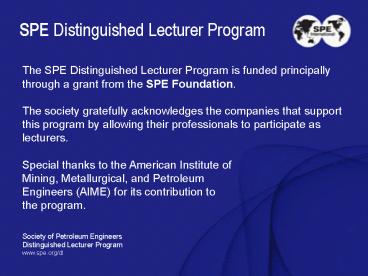SPE Distinguished Lecturer Program - PowerPoint PPT Presentation
1 / 32
Title:
SPE Distinguished Lecturer Program
Description:
Special thanks to the American Institute of. Mining, Metallurgical, and Petroleum ... et al., 'A New Set of Type Curves Simplifies Well Test Analysis', World Oil, May, ... – PowerPoint PPT presentation
Number of Views:183
Avg rating:3.0/5.0
Title: SPE Distinguished Lecturer Program
1
SPE Distinguished Lecturer Program
The SPE Distinguished Lecturer Program is funded
principally through a grant from the SPE
Foundation. The society gratefully acknowledges
the companies that support this program by
allowing their professionals to participate as
lecturers. Special thanks to the American
Institute of Mining, Metallurgical, and
Petroleum Engineers (AIME) for its contribution
to the program.
Society of Petroleum Engineers Distinguished
Lecturer Program www.spe.org/dl
2
A Twenty-Five Year Perspective on Use of
Pressure Transient Analysis
Robert H. Hite
Shell International EP
Society of Petroleum Engineers Distinguished
Lecturer Program www.spe.org/dl
3
Whats in the Title?
- Twenty-five Years
4
1983 Tektronix 4014Pressure Analysis
WorkstationPAWSCost 72,000 USD
5
Log-Log Diagnostic PlotBourdet 1983
Bourdet, D., et al., A New Set of Type Curves
Simplifies Well Test Analysis, World Oil, May,
1983, 95-106.
6
Whats in the Title?
- Twenty-five Years
- Use of Pressure Transient Analysis (PTA)
- This lecture illustrates how we have used PTA in
the last 25 years. By understanding that, you can
use this technology better in the future.
7
The Three Big Questions
- Why do we do it?
- How can we do it better?
- Whats the big picture?
8
Why Do We do Well Tests?
- Fluids - (gas or oil, PVT, surface processing
issues, pipeline design) - Rate - Reservoir (permeability)
- Rate - Completion (skin, length, conductivity)
- Continuity - (compartments, drainage area, nearby
boundaries)
9
Rationales for Exploratory and Appraisal Well
Tests
Rate Reservoir
Continuity
Rate Completion
Fluids
1993 Shell Case Studies
10
Continuity Well TestingThin-Beds Tahoe
SPE 24875 by C.D. White, et al.
11
Skin Analyses on Gulf of Mexico Wells
12
Skin Analyses on Gulf of Mexico Wells
13
Permanent Downhole Pressure Dataset
Pressure (psia)
q (stb/d)
2001
2003
2002
2004
Year
14
Optimum Value Testing
Flare
1991
Produce Liquids to Tanker
2001
15
Wireline Formation TesterMini Drill Stem Test
tool on Pipe
Another observation probe possible at 4.5 or 7m
Observation while Producing
Probe Module
2 m
Packer Module
1 m
Producing Interval
16
Distribution of Perm, 53-ft Thickness, Kavg
106 md
Red Producing Zone Gray Observation Probes
17
How does Perm-Thickness Change?
18
What is a horizontal well?
SPE 104480 by P.S. Fair
19
Varying Numbers of Beds in 88-degree Slant Well
Pseudo-Radial Flow
Linear Flow
Early Radial Flow
SPE 104480 by P.S. Fair
20
Varying Numbers of Beds in 88-degree Slant Well
Pseudo-Radial Flow
Linear Flow
Early Radial Flow
SPE 104480 by P.S. Fair
21
Summary and Conclusions
- Why do we do it?
- Pie chart 21-test 1993-lookback
- Continuity test - thin beds
- Skin distributions
- How can we do it better?
- Permanent downhole gauges for well and reservoir
management - Wireline Formation Tester cheaper and safer but
more information
22
Summary and Conclusions
- Whats the big picture?
- PTA results versus petrophysical lab perm data
- Geological layering for accurate interpretation
of horizontal wells - Most examples are from Gulf of Mexico but
principles are universal.
23
BackupExtras
24
Estimation of PTA Perm from Petrophysical Data
25
Rationales for Exploratory and Appraisal Well
Tests
Rate Reservoir
Continuity
Rate Completion
Fluids
1993 Shell Case Studies
26
Shell Offshore Inc.Average Ultimate Recovery
Mensa
Auger
Mars
Popeye
Ram Powell
27
1999 Deepwater Initial Well Rates
28
Optimal Value TestingWhat is it?
- Fit for purpose with lowest cost and HSE impact
- Any test where hydrocarbons are not produced
directly to surface
- New in toolbox
- Wireline formation test
- Closed system test
- Injection test
29
Comparison of Permeability Estimates
30
Sequential BUs Showing Loss of H
Acid Jobs
31
Pseudo-Skin Factors for Slant Wells
SPE 104480 by P.S. Fair
32
Holistic Well Testing
- All of the input data
- All of the gauges
- All of the build-up
- All of the build-ups
- All of the production history
- All of the non-well test data
- Operational
- Petrophysical
- Geological































